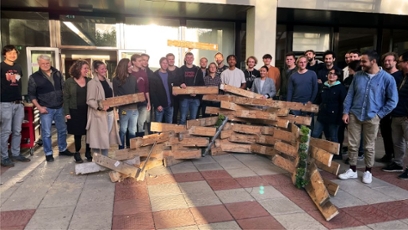From old floor parts to urban element
Robot Lab Makeathon delivers large-scale, circular urban furniture
1 Nov 2021 17:19 | Faculty of TechnologyThis prototype of a sturdy wooden urban furniture, the size of a parking lot space, is the outcome of the two-week Makeathon of the Robotic Production and Circular Materials minor, hosted by the Robot Lab of the Amsterdam University of Applied Sciences (AUAS). No fewer than 23 students, lecturers, researchers and practical partners participated in the event, which took place last October. The object was designed for the Making the Green Mile research project. From November 2021 part of it can be seen in the courtyard of De Leeuwenburg.
Is it elegant or excessively large? Viewers' opinions are divided. The more-than-two-meter-high wooden urban furniture that students, lecturers and researchers of the AUAS built earlier this month is certainly impressive. And this is exactly the intention, says Marco Galli, lecturer, researcher and program coordinator at the Digital Production Research Group of the AUAS. “With this design, we want to show how we can use waste materials with computational design and robotic production.”
Conversation piece
The urban furniture, made of old wooden floor parts from one of the depots of the Rijksmuseum in Amsterdam, was designed for the Making the Green Mile project. For this research project, the AUAS is working closely with architectural firm UNStudio and the companies GP Groot and Schijf Restoric, suppliers of residual and used building materials in the Amsterdam region. “UNStudio has been working for some time on plans for the redesign of the public space in the center of Amsterdam, especially the Stadhouderskade: one of the most polluting streets in the Netherlands,” says project leader Pinar Ates. “Together we have designed a large-scale prototype of urban furniture made from recycled materials, that will make this street more livable.” The object is intended as a conversation piece: it should encourage the municipality, companies and other parties to think about themes such as circularity and sustainable design, and initiate a conversation about greening the Stadhouderskade. There is special emphasis on finding ways to re-inhabit the city after the corona pandemic.
Making the Green Mile is a great opportunity for the AUAS Digital Production Research Group (DPRG) to further expand its knowledge of computational design and robotic production. “With these techniques, you can create complex, scalable designs that are not inferior to a standard design in terms of costs. This is interesting now that the demand for local mass customization is increasing in the design and construction industry,” says Galli. “And the great thing is that in this project we are allowed to work with waste materials, in line with our Upcycle Wood Factory research.”
Robotic Production and Circular Materials Minor
According to Galli and his colleagues, the project was ideal for the RP & CM Minor Makeathon, an event in which students, teachers and researchers optimize a design and robotically produce it in two weeks. “Working with students takes research to a higher level. They bring in fresh ideas and add critical thinking skills. In turn, the students acquire knowledge and skills that will benefit them for the rest of their careers, such as working in multidisciplinary teams,” the program coordinator says. Galli and his colleagues work together with a team of no fewer than 23 students. “The students have varying backgrounds and are in different study programs in and outside of AUAS. Many are also international students who are doing an exchange with us,” he illustrates.
Problem-Solving Skills
During the project, the students were given various situations to work on. For example, how much material is needed and in what condition does the wood have to be? Other questions were about the base on which the structure should be built and the design of the factory setup for the robotic production processes. “The first week they had to collect information, work on solutions and discuss together how to get the project done; therefore, they also learned how to collaborate and negotiate,” says Galli.
The students look back on the Makeathon with enthusiasm: “I really enjoyed working together with others,” says one of them. “And it was interesting to see how precisely you can work with a robot.” Another student was nervous about whether it would be possible to deliver a finished object by the end of the two-week period. “It was an ambitious project and we had very little material,” he explains.
Pride
During the two-week Makeathon, the students were able to create one part of the final object. DPRG researchers and interns will finalize the object over the coming weeks. Together with the municipality of Amsterdam, they are investigating when the object can be placed on the Stadhouderskade in Amsterdam.
“We did not know beforehand what the outcome would be,” Galli says. “We had never done such a project before with so many project partners and such a large team. Moreover, it was a complex design for which we had to put all the robots in our studio to work.”
This makes the program coordinator extra proud of the end result. “You can really go in all directions with computational design and robot production, as long as you have clear goals, build a collaborative framework and understand the design-to-production methodology,” he says.
His colleague Ates is also enthusiastic. “In the past two weeks I've seen exactly what we want to happen on a large scale in the future,” she says. “This brings us one step closer to mass customization with circular materials.”
Digital Production Research Group
The Making the Green Mile project contributes to the development of the Digital Production Research Group, which is part of the Center of Expertise Urban Technology of the AUAS. This research group works with wood in various projects, with the overarching theme: Upcycle Wood Factory.


